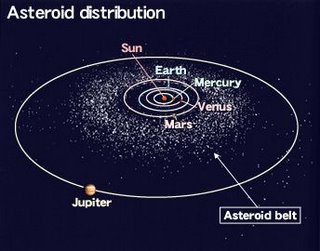

One can not discuss colonizing the solar system without mentioning asteroid mining. Harvesting the asteroid belt for minerals and metals will be critical towards the future space economy as some worlds (such as Mars and Jupiter's Galilean moons) lack the resources necessary to attract businesses and ultimately future colonists.
But in order to establish mining operations millions of miles away from habitable worlds, we need to find a way to feed those who will be doing the "dirty work" of mining these rocks that dance around our sun.
Although shipping food from Earth and Mars may be tolerable, it may impractical (not to mention expensive). Instead of shipping food, water and other items towards the asteroid belt, why not establish farming communities on Ceres instead?
 Despite lacking known metallic resources that would make it attractive towards future space corporations, Ceres does have one element that would make this asteroid worth its weight in gold--water. Scientists believe that Ceres could contain up to 200 million cubic kilometers of fresh water--about five times as much as planet Earth.
Despite lacking known metallic resources that would make it attractive towards future space corporations, Ceres does have one element that would make this asteroid worth its weight in gold--water. Scientists believe that Ceres could contain up to 200 million cubic kilometers of fresh water--about five times as much as planet Earth. By having access to a vast amount of liquid wealth, Ceres could easily grow the necessary food for future mining colonies, saving them both time and money as opposed to receiving rations from Earth.
Supplying future asteroid colonies with the necessary food will be difficult, if not nearly impossible as there are thousands (if not millions) of asteroids, each with its own chaotic orbit around the Sun. Without an orbital "ran de vue" point, permanent mining colonies may become "over looked," resulting in outposts being abandoned simply because a space settlement ran out of food.
 With the heart of the asteroid belt located around 2.7 AU (astronomical unit), Ceres lies in perfect position to supply future colonists with the necessary food supplies, as its orbit ranges between 2.55 and 2.98 AU. As the asteroid king makes its journey around the sun, mining colonies could be easily resupplied with food grown on the rocky world, enabling permanent outposts to focus on extracting minerals and precious metals.
With the heart of the asteroid belt located around 2.7 AU (astronomical unit), Ceres lies in perfect position to supply future colonists with the necessary food supplies, as its orbit ranges between 2.55 and 2.98 AU. As the asteroid king makes its journey around the sun, mining colonies could be easily resupplied with food grown on the rocky world, enabling permanent outposts to focus on extracting minerals and precious metals.Containing roughly 25% of the asteroid belts mass, Ceres may have the necessary gravity to allow for more plant life than would be possible in a micro gravity environment.
Although hovering around 3% (when compared to Earths), the gravity on Ceres may be tolerable to plant life, although humans may have to adjust to the low gravity by either finding chemicals to counter act atrophy or simply constructing artificial gravity space stations nearby.
Despite being recognized as a dwarf planet, Ceres will play a major role in mining operations within the asteroid belt, if not the solar system as a whole.
By simply acting as an agricultural world (or rather dwarf planet) it will save future Earth and (hopefully) Martian governments millions (if not billions) in transport costs, and may enable humanity to reap the rewards of harvesting the asteroid belt to the benefit of the human race.
Want more space geek news? Then subscribe below via email, RSS or twitter for free updates! Prefer another service? How about via RSS or follow Colony Worlds on Twitter!




![ColonyWorlds[at]Gmail[dot]com](http://img.photobucket.com/albums/v438/hiddennook/ColonyWorlds.png)







No comments:
Post a Comment
You can either visit the stars or watch them from afar.
But if you choose the former, you'll definitely get a better view.
~Darnell Clayton, 2007
Note: You do not need a Blogger account in order to comment, but you do need to solve the universal puzzle below.